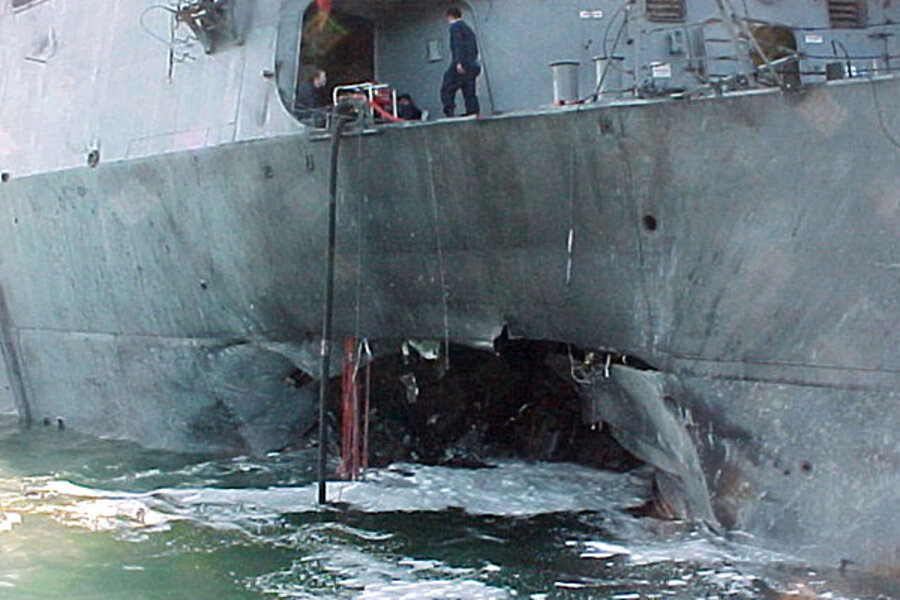What other Al Qaeda-linked attacks have involved Yemen?
Loading...
| Boston
Evidence is mounting that the explosives and expertise, such as it was, behind the failed attack on Northwest Airlines Flight 253, came from Yemen. Umar Farouk Abdulmutallab, who allegedly tried to destroy the plane with an explosive and liquid detonator, spent four months in the country until early December. Al Qaeda in the Arabian Peninsula, which is based in the country, has claimed responsibility for the attack, and ABC news quoted an unnamed FBI employee as saying Mr. Abdulmutallab has told interrogators that he received the explosives and his instructions there.
If Yemen does appear to be where this failed plot was hatched, it will not be the first time. The impoverished, California-sized country – on the important trading route linking the Red Sea to the Gulf of Aden and the Arabian Sea – was a way-station for the mostly Saudi and Yemeni mujahideen who flocked to Afghanistan to fight the Soviet occupation of that country in the 1980s. Al Qaeda sprang from among their ranks. Yemen has been a favored location for Al Qaeda militants to organize and strike out at Saudi Arabia, whose oil-flush monarchy they hate almost as mcuh as the United States.
Yemen's lawless hinterlands and arms trading culture have often given them the freedom and means to operate despite occasional crackdowns. Below is a brief list of Al Qaeda-linked attacks that were either carried out or were planned there.
1. Attempted Assasination of Prince Mohammed bin Nayef. In August 2009, Prince Nayef, son of Saudi Arabia's Interior Minister and himself the Kingdom's counter-terrorism chief, escaped with minor wounds when suicide bomber Abdullah Hasan Tali al-Asiri, infiltrated a receiving line at Nayef's home. Mr. Asiri, a wanted Al Qaeda militant who had fled to sanctuary in Yemen, contacted the prince's office saying he wanted to participate in the kingdom's amnesty program for Islamist militants who pledge to give up violence. He was invited to meet the prince outside his home, and blew himself up with a bomb concealed in his underwear that, like the bomb Abdulmutallab is alleged to have carried, was primarily composed of the high explosive PETN.
2. US Embassy car bomb attack. On Sept. 17, 2008, a suicide car bomb narrowly missed doing severe damage to the US Embassy in Sanaa. Six attackers dressed as policemen opened fire on guards from another vehicle and sought to maneuver the car bomb into position. The firefight with Yemeni police stopped them short of their goal. Six Yemeni police, the six attackers, and at least four bystanders were killed in the incident. Within days, the Yemeni government arrested more than a dozen men it said helped organize the attack and said they were affiliated with Al Qaeda.
3. Limburg oil tanker attack. On Oct. 6, 2002, an explosives-laden boat intercepted the French tanker as it steamed through the Gulf of Aden, an attack that mirrored the tactics used to strike the USS Cole. One sailor was murdered in the incident, and the ship spilled almost 100,000 barrels of oil into the Gulf. International shippers avoided Yemen's main port, Aden, for some months after the attack., for which Al Qaeda claimed credit. At least one of the men sentenced for his participation in the attack later escaped the heavily guarded jail in Sanaa that Mr. Badawi also escaped from.
4. Failed US Embassy attack. In June 2001, Yemeni police arrested a group of men near the US Embassy with explosives and maps of the area. They were later convicted along with others defendants in trials that found they were members of Al Qaeda and seeking to carry out terrorist attacks. At the trial, which also convicted Al Qaeda operatives accused of involvement in the attack on the Limburg, an attack on a helicopter carrying employees of a US oil company, prosecutors said the men were involved in a plot to murder the US Ambassador Edmund Hull and were also hoping to strike three other embassies. A 2003 Al Qaeda attempt to truck-bomb the British Embassy in Sanaa was also foiled
5. USS Cole. The October 12, 2000, suicide attack by a small craft packed with explosives killed 17 sailors on the USS Cole, an American destroyer berthed in Aden harbor for a fuel stop. Osama bin Laden took credit for the attack in a video released shortly before the Sept.11 attack the following year. Though Yemen's initial response to the attack was robust, with a number of arrests and trials, every man arrested or convicted in connection with attack in Yemen has since either escaped from prison or been pardoned. Jamal al-Badawi, one of the senior leaders of the plot, escaped from prison twice. After his second escape, he turned himself in to Yemeni authorities in 2007 in a negotiated deal that ended with his release from prison in exchange for a promise of good behavior. At least two of the convicted attackers released from Yemeni custody later participated in suicide attacks in Iraq.





